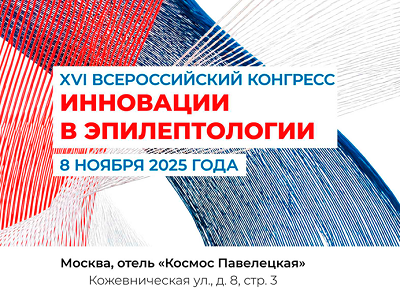Vol 2, No 2 (2010)
ORIGINAL ARTICLES
6-9 754
Abstract
It is known than nearly two thirds of epileptic patients can be cured by proper therapy which can be prescribed after establishing of correct diagnosis. One of the most informative instrumental diagnostic techniques is video-EEG monitoring. This communication describes the role of clinical telemetric video-EEG examination in establishing and specifying the diagnosis of epilepsy.
17-24 2337
Abstract
Hence anxiety disorders are frequently observed in the clinical picture of epilepsy these must be considered when choosing adequate therapy. Purpose of this study was evaluation therapeutic efficacy and adverse effects in people with epilepsy treated with pregabalin (PGB) 300 mg per day (20 patients), alprazolam (ALP) 1,5 mg per day (20 patients) and P (18 patients). In this study several characteristics had been evaluated in each group: seizure frequency, severity of anxiety disorder and adverse effects of the drugs administrated. In 50-days therapy of epileptic patients PGB demonstrated high efficacy and safety in treatment pharmacoresistant epilepsy comorbid with mental disorders specifically in treatment epilepsy with generalized anxiety disorders. PGB proved to be safer compared with ALP since no habituation elaborated. In durable therapy of anxiety disorders in epilepsy PGB must be recommended.
25-31 2249
Abstract
To investigate physical development and dysembryogenetic stigmata in children born to epileptic mothers. Materials: 50 patients (main group) are children born to epileptic mothers, and 50 children (control group) who are born to somatically healthy mothers. Study method: clinico-neurological method. Results: For the moment of investigation, no reliable, statistically significant differences in body mass, height, head or chest circumference have been found between the group of children born to epileptic mothers and group of children born to somatically healthy mothers (р > 0.05). In 20 (40%) of examined children the dysembryogenetic stigmata were found. Statistically significant changes in children born to epileptic mothers, and having dysembryogenetic stigmata, were found as compared to children born to somatically healthy mothers. Conclusions. 1) The rate of dysembryogenetic stigmata found in children born to epileptic mothers, who took anti-epileptic drugs (AED) during pregnancy, exceeds by approximately 10-fold the population indices. 2) Physical development of children born to epileptic mothers did not differ from that of children born to somatically healthy mothers. 3) The choice of AED for treatment during pregnancy should take into account the AED relative teratogenic potential (development of congenital abnormalities and effect on further cognitive development), as well as AED efficiency against seizures during pregnancy, depending on the form of epilepsy.
17-24 3047
Abstract
Hence anxiety disorders are frequently observed in the clinical picture of epilepsy these must be considered when choosing adequate therapy. Purpose of this study was evaluation therapeutic efficacy and adverse effects in people with epilepsy treated with pregabalin (PGB) 300 mg per day (20 patients), alprazolam (ALP) 1,5 mg per day (20 patients) and P (18 patients). In this study several characteristics had been evaluated in each group: seizure frequency, severity of anxiety disorder and adverse effects of the drugs administrated. In 50-days therapy of epileptic patients PGB demonstrated high efficacy and safety in treatment pharmacoresistant epilepsy comorbid with mental disorders specifically in treatment epilepsy with generalized anxiety disorders. PGB proved to be safer compared with ALP since no habituation elaborated. In durable therapy of anxiety disorders in epilepsy PGB must be recommended.
SCIENTIFIC SURVEYS
10-16 1285
Abstract
This article presents current views over the issue of parasomnias, and provides their classification including the awakening disorders, parasomnias linked to phase of fast sleep, and other parasomnias. The role of objective sleep examination by polysomnography with mandatory video monitoring is emphasized. For differential diagnosis of parasomnia causes, the most important is the revelation of epileptic nature of this phenomenon. In case when parasomnias do not threat patients’ social adaptation, patients require no therapy. At the same time, some medications can be administered that are mostly represented by drugs increasing cerebral GABA-ergic potential, antidepressants and anxiolytics, as well as non-medicinal therapy, such as psychotherapy, behavioral therapy, acupuncture or phototherapy. A particular attention should be paid to adult parasomnias which occur for the first time, since these, as a rule, are secondary and disguise other underlying diseases.
32-38 878
Abstract
Nowadays, normalization of quality of life is considered to be one of key targets during epilepsy treatment. Given a high prevalence of epilepsy in pediatric and juvenile patients, and particular importance of this age period for the whole further human life, studying of quality of life is a topical issue. However, the first serious studies of quality of life in pediatric and juvenile epileptic patients have only begun in the 90th of the 20th century, i.e., significantly later than those in adult epileptic patients. The insufficient number of scales and methods in pediatrics is linked to objective impediments with definition of quality of life in children and adolescents. This article highlights the main issues of studying quality of life in this age category, shows the particulars of studying quality of life in various age categories and marks out the tasks for future investigations.
39-41 685
Abstract
Treatment of epilepsy, a disease which is high incident and very diverse in terms of clinical forms, in children, is one of the key issues in the pediatric epileptology. New antiepileptic drugs have been developed recently, and special pediatric pharmaceutical forms are being developed, among them - Topiramate capsules. The publication discusses evaluation of two patient groups. Children from group one received topiramate tablets (Topamax®) followed by a switch to the study drug in capsules. Children from group two received topiramate capsules alone or in combination with other treatments from the baseline. The analysis demonstrated bioequivalence of Topamax® tablets and capsules, its high efficacy and good tolerability, as well as convenience of administration in children.
ISSN 2077-8333 (Print)
ISSN 2311-4088 (Online)
ISSN 2311-4088 (Online)










































